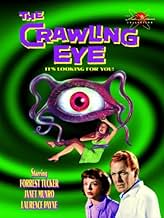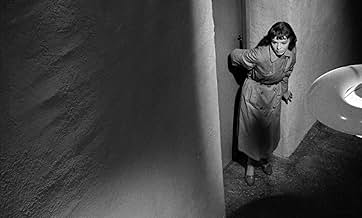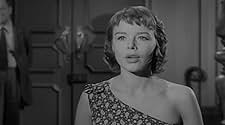IMDb-BEWERTUNG
5,2/10
5251
IHRE BEWERTUNG
Füge eine Handlung in deiner Sprache hinzuA series of decapitations on a Swiss mountainside appear to be connected to a mysterious radioactive cloud.A series of decapitations on a Swiss mountainside appear to be connected to a mysterious radioactive cloud.A series of decapitations on a Swiss mountainside appear to be connected to a mysterious radioactive cloud.
Empfohlene Bewertungen
I kind of liked this movie for all of it's B movie glory. It's a great 50s sci-fi movie. It's a little boring but I thought the monster was pretty good. A great late night or after noon viewing, not even all that scary. Good solid drive in movie or the kind of movie that you would watch on TV late at night. I laughed at various points during the movie but they did a pretty good job with the monster. Even though, it's kind of boring, it's good to watch if you like schlock movies from the 50s like I do. I wish it had been a little more entertaining and scary. But I do have affection for the movies of this period. You can tell that they were trying to keep the cost down. The acting was okay, what you would expect to find in these types of movies. All around fun and excitement for a lazy afternoon.
When I first saw this movie as a kid, it really scared me. But when I finally got it on tape and saw it uncut . . . those eyes were not nearly as scary as I remembered. Some highlights: In the beginning, on the train, watch Forrest Tucker's newspaper. The plot moves along pretty well, one of the best scenes takes place in a cabin, where an unsuspecting climber suddenly finds himself alone when his friend takes a midnight stroll. As he is talking to Forrest Tucker at the lodge he hears . . . a noise outside! Has his friend returned? Go ahead, stupid, open the door. AHHHH! What is it? The line goes dead. They find him later, but he's lost his head. When we finally we get to see these creatures, one is trying to steal a little girl's ball, along with the little girl. With everyone crowded in the halls of the observatory, our hero and his scientific side-kick decide to bomb their uninvited guests. "Bomb a cloud?" Neat bomb. It leaves the eyes dripping and in need of eye drops. It doesn't hurt the building, even though it was a direct hit on the roof. Oh, and there WAS that hole in the wall made by an eye trying to grab Janet Murno. See this movie. It's a real "eyeful."
I have a huge and very soft spot for 1950s sci-fi films with freakish aliens and/or monsters. Be forewarned - my view of this film is definitely colored by my unhealthy interest in these films.
This is a true archetypal classic of the genre.
*** Weird psychic sisters, *** alien mystery clouds, *** giant creeping cyclopes with tentacles, *** secret government agencies investigating the paranormal, *** possession, *** zombies, ***
Forest Tucker(!)
This is a very entertaining low-fi, low-brow, B/W monster movie. I am convinced that the writers were asked to include every element of contemporary supernatural, sci fi and imaginative fiction stories and, kudos to them - they pulled it off! Stephen King's Dreamcatcher owes a huge debt to this beauty. If you think about it, Dreamcatcher is almost a rewrite of this film, with aliens that are just a little less ridiculous and a different narrative. And the biggest surprise of all - Forest Tucker can act! His F Troop character was not the only personality in his repertoire!
Remarkably, the absurdity of the plot is not used as an excuse for exceedingly bad special effects.
This is a little gem of a 50s pulp film. It's goofy as hell, fun, well executed, and well worth a sleepless night. Far more entertaining that the Creature from the Black Lagoon, and many others.
This is a true archetypal classic of the genre.
*** Weird psychic sisters, *** alien mystery clouds, *** giant creeping cyclopes with tentacles, *** secret government agencies investigating the paranormal, *** possession, *** zombies, ***
Forest Tucker(!)
- it's all here.
This is a very entertaining low-fi, low-brow, B/W monster movie. I am convinced that the writers were asked to include every element of contemporary supernatural, sci fi and imaginative fiction stories and, kudos to them - they pulled it off! Stephen King's Dreamcatcher owes a huge debt to this beauty. If you think about it, Dreamcatcher is almost a rewrite of this film, with aliens that are just a little less ridiculous and a different narrative. And the biggest surprise of all - Forest Tucker can act! His F Troop character was not the only personality in his repertoire!
Remarkably, the absurdity of the plot is not used as an excuse for exceedingly bad special effects.
This is a little gem of a 50s pulp film. It's goofy as hell, fun, well executed, and well worth a sleepless night. Far more entertaining that the Creature from the Black Lagoon, and many others.
I happen to think this is one of the more enjoyable films I have seen that was made in the 1950's. Deep down it is typical 50's "mutated monster" fare but it really is so much more. A strange mist overtakes an Alpine village and turns out to be a decapitating giant eyeball. It sounds pretty hokey I know and the special effects are poor but it was the 1950's afterall and there is a fair amount of blood that is featured which was a surprise to me. When the two hikers are found dead you can see their bloody, mangled faces. And in one decapitation scene you can see the blood flying. The performances are fine in this one including a robust performance from the great Forrest Tucker. Plenty of atmosphere in this one also. All in all I would highly recommend this one. It's a lot of harmless fun and when not taken seriously, as it seems to have been by some of the reviewers here, it is a highly enjoyable film.
A series of decapitations on a Swiss mountainside appear to be connected to a mysterious radioactive cloud, not unlike one that appeared in the Andes years earlier.
Although one of the earliest films to be lampooned on "Mystery Science Theater 3000", there is no denying the growing reputation this movie has received over the years: not only was it referenced in Stephen King's "It", but was also the primary influence behind John Carpenter's minimalist masterpiece "The Fog" (which itself has gone on to influence others).
"Crawling Eye" was the debut feature for director Quentin Lawrence, and probably remains his best-known work. Writer Jimmy Sangster (adapting the work of Peter Key) had only been working a few years, but was a rising star with such Hammer classics as "Dracula" and "Curse of Frankenstein" under his belt. Here he crafts a tale of science gone wrong mixed with the living dead, and done to perfection.
Most interestingly, shortly before the film was released, Lawrence directed a 6-part television miniseries with Key writing the episodes. Today, no copies are thought to exist, and there is no way to know what changes were made for the big screen, as well as what cuts had to be administered to accommodate the shorter running time.
Leading the cast is Forrest Tucker as United Nations troubleshooter Alan Brooks. Tucker had been in nearly 100 films during the 1940s and 50s, and easily handles his role here as the hero -- part action star, part scientific genius. He is assisted by Warren Mitchell as a caricatured Swiss professor (a portrayal which provides the film's only comic relief).
The standout performance comes from Janet Munro as a semi-psychic young woman who goes into trances when she nears the cloud. One gets the impression that she had a bright career before her, and indeed was given a Golden Globe in 1960. Sadly, she passed unexpectedly at age 38.
Today's audiences might find some of the special effects cheesy. Obviously the crew used miniature sets and plenty of rear projection. But in general, there is no denying the impressive use of fog, the freezing effects and the creepy realism of the titular eye. While other 1950s films were busy using radiation as a plot device for large bugs, this one went in a completely different direction -- possibly the only film of its kind.
Notably, "Crawling Eye" was the final film to be produced by Southall Studios, one of the earliest pioneer film studios in the UK, which had made a steady stream of films since 1924. They went out on a high note, which is always nice.
Although one of the earliest films to be lampooned on "Mystery Science Theater 3000", there is no denying the growing reputation this movie has received over the years: not only was it referenced in Stephen King's "It", but was also the primary influence behind John Carpenter's minimalist masterpiece "The Fog" (which itself has gone on to influence others).
"Crawling Eye" was the debut feature for director Quentin Lawrence, and probably remains his best-known work. Writer Jimmy Sangster (adapting the work of Peter Key) had only been working a few years, but was a rising star with such Hammer classics as "Dracula" and "Curse of Frankenstein" under his belt. Here he crafts a tale of science gone wrong mixed with the living dead, and done to perfection.
Most interestingly, shortly before the film was released, Lawrence directed a 6-part television miniseries with Key writing the episodes. Today, no copies are thought to exist, and there is no way to know what changes were made for the big screen, as well as what cuts had to be administered to accommodate the shorter running time.
Leading the cast is Forrest Tucker as United Nations troubleshooter Alan Brooks. Tucker had been in nearly 100 films during the 1940s and 50s, and easily handles his role here as the hero -- part action star, part scientific genius. He is assisted by Warren Mitchell as a caricatured Swiss professor (a portrayal which provides the film's only comic relief).
The standout performance comes from Janet Munro as a semi-psychic young woman who goes into trances when she nears the cloud. One gets the impression that she had a bright career before her, and indeed was given a Golden Globe in 1960. Sadly, she passed unexpectedly at age 38.
Today's audiences might find some of the special effects cheesy. Obviously the crew used miniature sets and plenty of rear projection. But in general, there is no denying the impressive use of fog, the freezing effects and the creepy realism of the titular eye. While other 1950s films were busy using radiation as a plot device for large bugs, this one went in a completely different direction -- possibly the only film of its kind.
Notably, "Crawling Eye" was the final film to be produced by Southall Studios, one of the earliest pioneer film studios in the UK, which had made a steady stream of films since 1924. They went out on a high note, which is always nice.
Wusstest du schon
- WissenswertesJohn Carpenter has said that this film, with its creatures hidden in the clouds, was partly the inspiration for his film The Fog: Nebel des Grauens (1980).
- PatzerAfter Brett gashes his forehead in a fight, they discover he does not bleed and that he is already dead. Yet Professor Crevette gives Brett an inject-able sedative in the arm. No blood means there is no way for the drug to travel to his brain.
- Zitate
Sarah Pilgrim: *Was* there an accident, Mister Klein?
Mayor Klein: O-On a mountain, uh, dese things sometimes happen.
- Crazy CreditsThe film's opening credits flash onto the screen when the passenger train rolls into the darkness of a tunnel.
- VerbindungenEdited into FrightMare Theater: The Crawling Eye (2017)
Top-Auswahl
Melde dich zum Bewerten an und greife auf die Watchlist für personalisierte Empfehlungen zu.
- How long is The Crawling Eye?Powered by Alexa
Details
- Erscheinungsdatum
- Herkunftsland
- Sprachen
- Auch bekannt als
- The Crawling Eye
- Drehorte
- Alliance Film Studios, St Margarets, Twickenham, Middlesex, England, Vereinigtes Königreich(studio: made at Alliance Film Studios Ltd)
- Produktionsfirma
- Weitere beteiligte Unternehmen bei IMDbPro anzeigen
- Laufzeit1 Stunde 22 Minuten
- Farbe
- Seitenverhältnis
- 1.66 : 1
Zu dieser Seite beitragen
Bearbeitung vorschlagen oder fehlenden Inhalt hinzufügen




























